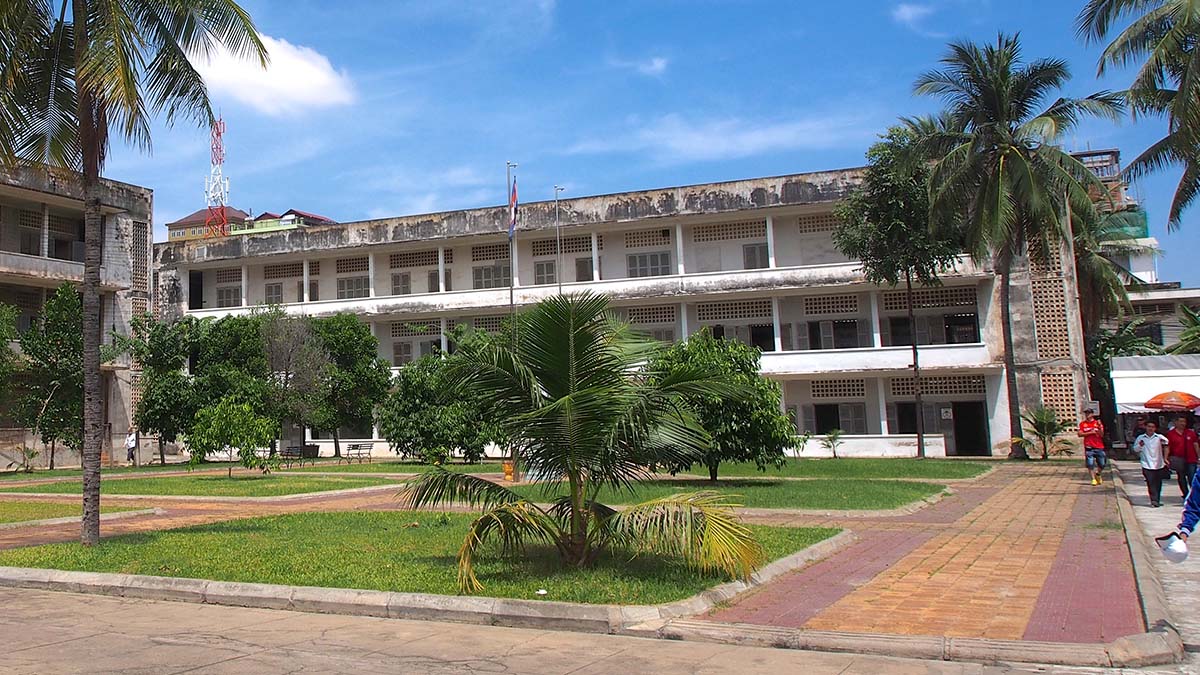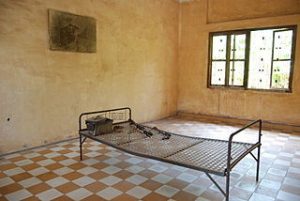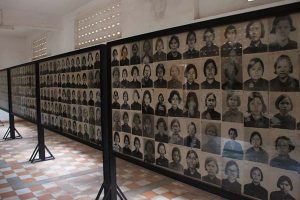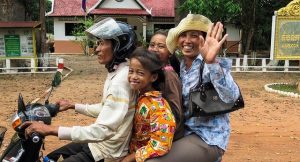
Phnom Penh, Cambodia
by Lee Beavington
Rusted barbed wire crowns the two walls that enclose the dilapidated school. A few Cambodians stand outside the only entrance. One is on crutches; he holds a cap for change, his leg amputated above the knee. Most tourists walk by without a second glance, lost in their own dismay, having witnessed far worse than the carnage caused by forgotten land mines.
In 1975, the insurgent Khmer Rouge seized the capital, Phnom Penh, and with it the entire country. They restarted the calendar (calling it Year Zero), abolished currency, split up families, and enslaved everyone – including children, the elderly and the infirm – into 15-hour-a-day labour. During the three years, eight months, and twenty-one days they were in power, an estimated two million Cambodians lost their lives from starvation, overwork or execution. Twenty thousand of those were caged within these institutional walls, the school that came to be known as Tuol Sleng, or Security Prison 21.
To visit a country and not pay respect to their people, and what they have gone through, seems somehow discourteous. Too often tourists are armed only with a camera and a long itinerary, and I am determined to do more than conquer Angkor Wat and flee home with a full memory card. Many people flash photos inside Tuol Sleng, ghastly mementos of conditions that would make concentration camps seem almost agreeable in comparison. I take only one shot–so I will not forget.
 The first set of classrooms turned prison cells includes iron barred windows, and a single bed with an attached shackle. A blown-up photo of a dead Cambodian, barely recognizable as a human, rests hauntingly above the bed. The very educators that worked in this room as teachers were incarcerated in these hellish conditions. And when they died, in a final act of grievous disrespect, a photo was taken of their emaciated, bloodied body.
The first set of classrooms turned prison cells includes iron barred windows, and a single bed with an attached shackle. A blown-up photo of a dead Cambodian, barely recognizable as a human, rests hauntingly above the bed. The very educators that worked in this room as teachers were incarcerated in these hellish conditions. And when they died, in a final act of grievous disrespect, a photo was taken of their emaciated, bloodied body.
Engineers, ministers, farmers, diplomats, even monks were brought here. Interrogated and tortured, they were coerced to follow nine strict rules, including Do nothing. Sit still and wait for my orders and While getting lashes or electrification you must not cry at all. The unfortunate survivors were taken to the Killing Fields outside Phnom Penh and forced at gun point to dig their own graves.
In the school courtyard stands a set of high bars with rope where children did their exercises. Except the Khmer Rouge used it to hang people upside down until they lost consciousness, and then plunged their heads underwater. A playground converted into a gallows.
 One exhibit in particular brings me to stunned silence. The room has photos of every victim, a casualty catalogue meticulously recorded by the Khmer Rouge. Each board displays hundreds of black and white photos, arranged like a giant checkerboard–thousands stretch from one room to the next. My girlfriend barely crosses the threshold before seeking sanctuary in the courtyard, too distraught to continue. I console her and then return in stubborn determination. To do what, I’m not sure. But I need to see what these people have seen, even if I can only manage a small glimpse, in the hopes of finding some sense of understanding.
One exhibit in particular brings me to stunned silence. The room has photos of every victim, a casualty catalogue meticulously recorded by the Khmer Rouge. Each board displays hundreds of black and white photos, arranged like a giant checkerboard–thousands stretch from one room to the next. My girlfriend barely crosses the threshold before seeking sanctuary in the courtyard, too distraught to continue. I console her and then return in stubborn determination. To do what, I’m not sure. But I need to see what these people have seen, even if I can only manage a small glimpse, in the hopes of finding some sense of understanding.
Vacant stares from eyes that witnessed daily horrors follow me as I venture sluggishly around the first room. I move from one dire face to the next: hollow, gaunt, not an ounce of spirit remaining in the shadowed windows of their eyes. Each person bears a numbered necklace, a way for the Khmer Rouge to keep track of every victim. I feel like a scientist, an objective and impartial observer of Cambodian history. Purely a defensive mechanism to keep my emotions at bay, for I know how easily I could be overwhelmed.
From the corner a woman emerges, tears streaming behind the hand on her cheek. I approach the area with trepidation, wondering what greater horror I will find. I move around one display to another. A hundred sets of eyes gaze back at me, their colour and light gone. And yet each seems to be screaming: why? My heart bursts, unable to contain its sorrow and despondency any longer. Tears unashamedly fall, heavy and full. I cannot understand.
Children fill the entire board. One photo after another; a boy that just entered teenagehood; a pre-pubescent girl; countless other toddlers younger than my own nephews. In fact, two thousand children were killed at Tuol Sleng. In the school where they had come to learn, to feel safe, to play in the courtyard, they were instead separated from their families, shackled, tortured, and murdered.
I flee from the room, not with remorse, but with a rising nausea originating from incredulous disbelief. The neighbouring rooms offer no solace, photos of joyless mothers clutching babies to their shrunken breasts, naked men with protruding hip bones. Those little eyes follow me wherever I go, begging, pleading, surrendering. Why?
As I step stoically from classroom to classroom, floor to floor, building to building, my body becomes numb. I see cells made of hastily stacked bricks, walls with layered bloodstains, interrogation rooms with torture devices at which even the most hardened would cringe. Yet I stumble across one alcove of comfort, one place where no tainted remnant of the Khmer Rouge lingers.
Hidden underneath a staircase is a wall of colourful graffiti. Words are scribbled in pencil, pen, or whatever else visitors to the genocide museum had with them.
Never again.
Give peace a chance.
God is love.
It’s not common to find refuge in graffiti, let alone proclamations of hope and faith. But here, in one corner of the former school, are overwhelmingly positive affirmations. I breathe in the soul-lifting messages like a deep-sea diver who has come up for air.
Not all responses are so gracious. One of the most disheartening sights comes towards the end of my gloomy tour. I discover more graffiti, this time on framed photos of members of the Khmer Rouge. One can understand the survivors’ anger – utter hatred – at a regime that eradicated one-fifth of the country’s population. Yet even the men and women whose association with the Khmer Rouge was questionable are defaced by the bold markings of outraged Cambodians.
I go back to the courtyard and find my girlfriend. While we sit in silence, the couple beside us begins to argue. Their words escalate in a petty dispute about itinerary. I can’t help but think, hate breeds hate. If one cannot forgive, then hate endures.
 In my visit to Cambodia, I truly cherished the kind-hearted people and their cheerful smiles. Despite living impoverished lives, with polluted water, diminutive houses that sleep dozens, back country littered with land mines, and where a good day is marked by having three meals, they never failed to greet me with generosity and warmth. Tuol Sleng revealed two extremes of the nature of our species: how the power of a misguided few is capable of producing great evil, and the strength of the human spirit in overcoming unspeakable atrocities. Cambodians struggled through a horrendous 20th century, with occupations by nearly every neighbouring country, covert carpet-bombing by US forces for four years, and devastating famine following the Khmer Rouge regime. They have persevered through it all.
In my visit to Cambodia, I truly cherished the kind-hearted people and their cheerful smiles. Despite living impoverished lives, with polluted water, diminutive houses that sleep dozens, back country littered with land mines, and where a good day is marked by having three meals, they never failed to greet me with generosity and warmth. Tuol Sleng revealed two extremes of the nature of our species: how the power of a misguided few is capable of producing great evil, and the strength of the human spirit in overcoming unspeakable atrocities. Cambodians struggled through a horrendous 20th century, with occupations by nearly every neighbouring country, covert carpet-bombing by US forces for four years, and devastating famine following the Khmer Rouge regime. They have persevered through it all.
If there is one thing I can now understand, it is the smile on the face of every Cambodian.
If You Go:
Tuol Sleng is located in Cambodia’s capital, Phnom Penh. A visit is not for the faint of heart. You must be centered and strong. Be prepared for illustrations of gruesome torture techniques and cabinets full of human skulls. Entrance fee is minimal. Beggars often congregate outside the former school’s entrance. Donations are currently being sought to help preserve the site. When inside, you are asked to refrain from making noise, and to “be concentrated spiritually and physically in order to pay respect to the souls of victims.”
Private Full Day Phnom Penh City Tour
Phnom Penh Highlights
Half-Day Phnom Penh Food Tour
About the author:
Lee Beavington works in biology, toils in writing, swings in dance, dabbles in Buddhism, revels in travel, and specializes in being. His novella, “Evolution’s End”, was published in Writers of the Future XXII. The curious can find out more at www.leebeavington.com. Read his weekly 100-word bioflash!
Photo Credits:
Tuol Sleng Genocide Museum exterior by Clay Gilliland / CC BY-SA
Torture room by Paul Mannix / CC BY
Photos of genocide victims by Christian Haugan via Flickr
Cambodian family by kolibri5 from Pixabay



Leave a Reply
You must be logged in to post a comment.